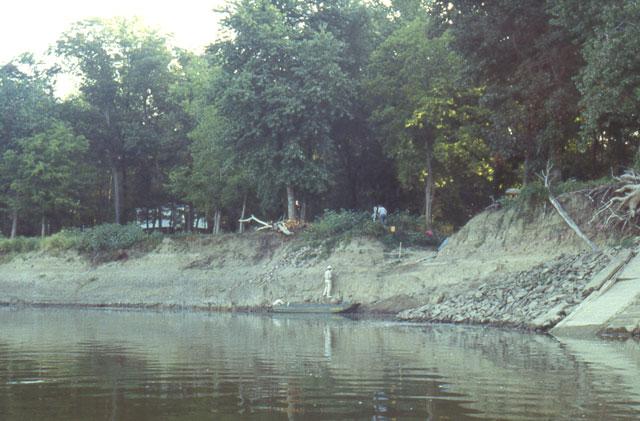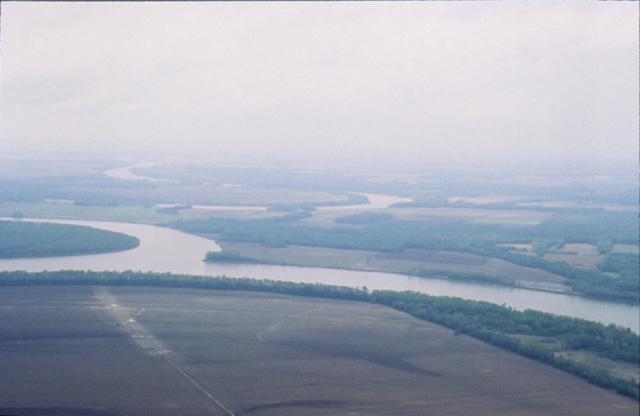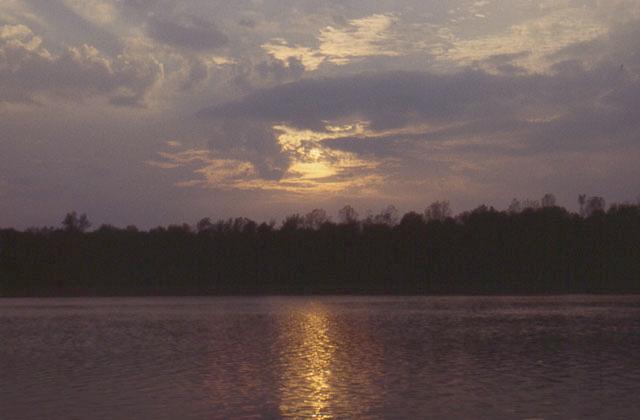Bone Bank Archaeological Research
Posey County, Indiana
Rescue Excavations at the Bone Bank Archaeological Site in Southwestern Indiana
 Introduction
Introduction
 Indiana's First Archaeological Excavation
Indiana's First Archaeological Excavation
 Survey and Testing
Survey and Testing
 Significance
Significance
 Project Goals
Project Goals
 Research Stages
Research Stages
 Expected Results
Expected Results
 Bone Bank in 2000
Bone Bank in 2000
 Planning for 2001
Planning for 2001
 Current Work
Current Work
 In the News
In the News
 Fall 2001 Lecture
Fall 2001 Lecture
 References
References
 Geomorphological History
Geomorphological History
 Links
Links
 Maps
Maps

INTRODUCTION AND LOCATION
The Bone Bank archaeological site (12 Po 4), located on the bank of the Wabash River in far southwestern Indiana, is a late prehistoric (protohistoric) Native American village site. Early in the period of historic European settlement, the site became famous because of the burials that eroded from the site on the cutbank of the river, as well as the many artifacts that were collected. In fact, the Bone Bank site became a landmark for early river travelers in the early 1800s.
Today, the cemeteries at Bone Bank have long been eroded away, as has much of the village residential area. Luckily, a small part of the site is still intact, perhaps 2-3% based on recent fieldwork. However, the sitecontinues to erode every year. For this reason, rescue excavations are needed to recover archaeological data and collections at Bone Bank.
A rescue excavation project at Bone Bank has been funded by the State of Indiana through the Wabash River Heritage Corridor Program. Funds and services from individuals, groups and educational institutions make-up the required matching funds for the grant. Rescue excavations will take place in 2000 and 2001 under the direction of archaeologist Cheryl Munson, Indiana University.
Looking northeast; view of the river cutbank from the Wabash River. Patrick Munson in the center is surveying the river bank and flagging artifacts in the buried cultural layer. The soil in the cultural zone two inches below the surface is slightly darker.

The Bone Bank site is known archaeologically as one of the communities of the Mississippian Caborn-Welborn culture, a late prehistoric Native American culture which occupied the Mouth of the Wabash, ca. A.D. 1400-1700 (Munson and Green 1973; Green and Munson 1978; Pollack 1998). People of earlier cultures also used the Bone Bank area for camps, but only scant evidence has been found. A single PaleoIndian point of the general type dating to 9,000-10,000 B.C. attests to the earliest period of use of the area (Adams 1949).
The Caborn-Welborn people were the only ones to have had a substantial community at Bone Bank. This culture developed after the principal town of the Angel culture, Angel Mounds (Black 1967), fell into decline and became abandoned. Bone Bank became one of the major villages of this later culture, with others being the villages at the Hovey Lake, Murphy, and Slack Farm archaeological sites (Figure 1). Size estimates for Bone Bank suggest it may have had more than 500 occupants at its peak. All of the larger Caborn-Welborn villages were surrounded by smaller villages, hamlets, and farmsteads, which together made up a sizable Native American presence just before the dawn of the historic era in our region. For unknown reasons, the Caborn-Welborn people abandoned the Mouth of the Wabash about a century before any of the earliest Euro-American settlement in 1790-1810. Knowing when the major communities were established and abandoned is key in understanding the cultural development and decline of the last Native American population to occupy southern Indiana (Munson 1983; Pollack 1998).
Location of the Bone Bank site and other Caborn-Welborn phase Mississippian sites.

The Bone Bank site lies about 3 km (1.8 miles) north of the confluence of the Wabash and Ohio Rivers, and 11 river-km (6.8 river-miles) above the mouth of the Wabash on the second bend of its meandering course.
Aerial view of the Bone Bank site.

Aerial view of the rivers and sloughs at the confluence of the Ohio and Wabash Rivers.

Bone Bank is also located immediately northwest of a backwater swamp called
Cypress Slough, which is a cut-off former channel of the Wabash River. Current
research (Munson 2000) has shown that the swamp would have been a large backwater
lake when the site was occupied [Geomorphological
History ]. The site location afforded ample resources for the
prehistoric villagers who fished, hunted, farmed, and traded for raw materials
and manufactured products. These same kinds of pursuits continue in southern
Indiana today, but economic priorities are reversed, with farming and trade
being dominant.
Presently the Bone Bank site is owned primarily by Allen Gray Limited Partnership II, which farms extensively in Posey County. The site was farmed early in the 1800s, and still today is locally known as the Reeves farm. The Bone Bank site, however, has not been farmed for decades because the best land had washed away. A small area at the north end of the site is in different private ownership, where a series of cabins comprise a river camp. This seasonal community is known as Oak Grove.
Sunset at Bone Bank, looking across the Wabash River to Illinois..

Return to Top
Last updated on 8/06/2001
Send Comments to: munsonc@indiana.edu
Site sponsored by Indiana University
 Introduction
Introduction
 Indiana's First Archaeological Excavation
Indiana's First Archaeological Excavation
 Survey and Testing
Survey and Testing
 Significance
Significance
 Project Goals
Project Goals
 Research Stages
Research Stages
 Expected Results
Expected Results
 Bone Bank in 2000
Bone Bank in 2000
 Planning for 2001
Planning for 2001
 Current Work
Current Work
 In the News
In the News
 Fall 2001 Lecture
Fall 2001 Lecture
 References
References
 Geomorphological History
Geomorphological History
 Links
Links
 Maps
Maps





